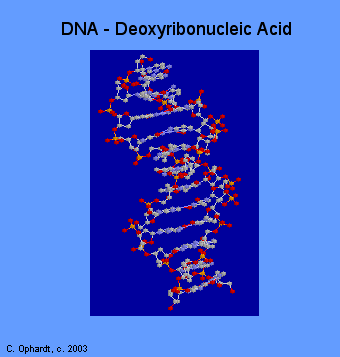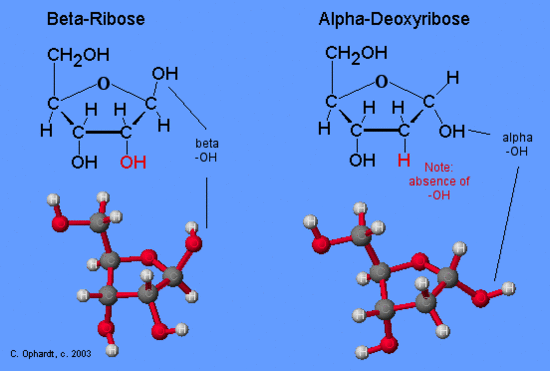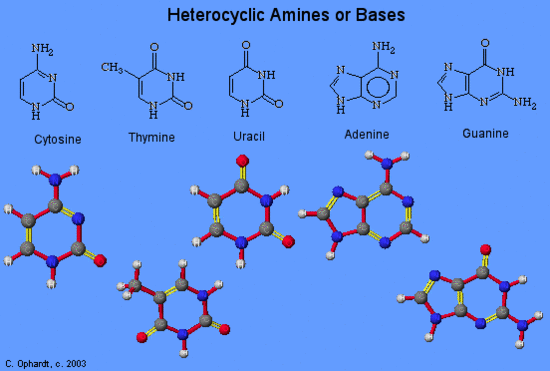Nucleic Acids
- Page ID
- 56116
The nucleic acids are informational molecules because their primary structure contains a code or set of directions by which they can duplicate themselves and guide the synthesis of proteins. The synthesis of proteins - most of which are enzymes - ultimately governs the metabolic activities of the cell. In 1953, Watson, an American biologist, and Crick, an English biologist, proposed the double helix structure for DNA. This development set the stage for a new and continuing era of chemical and biological investigation. The two main events in the life of a cell - dividing to make exact copies of themselves, and manufacturing proteins - both rely on blueprints coded in our genes.
Introduction
There are two types of nucleic acids which are polymers found in all living cells. Deoxyribonucleic Acid (DNA) is found mainly in the nucleus of the cell, while Ribonucleic Acid (RNA) is found mainly in the cytoplasm of the cell although it is usually synthesized in the nucleus. DNA contains the genetic codes to make RNA and the RNA in turn then contains the codes for the primary sequence of amino acids to make proteins.

Nucleic Acid Parts List
The best way to understand the structures of DNA and RNA is to identify and examine individual parts of the structures first. The complete hydrolysis of nucleic acids yields three major classes of compounds: pentose sugars, phosphates, and heterocyclic amines (or bases).
Phosphate
A major requirement of all living things is a suitable source of phosphorus. One of the major uses for phosphorus is as the phosphate ion which is incorporated into DNA and RNA.
Pentose Sugars
There are two types of pentose sugars found in nucleic acids. This difference is reflected in their names--deoxyribonucleic acid indicates the presence of deoxyribose; while ribonucleic acid indicates the presence of ribose. In the graphic below, the structures of both ribose and deoxyribose are shown. Note the red -OH on one and the red -H on the other are the only differences. The alpha and beta designations are interchangeable and are not a significant difference between the two.

Heterocyclic Amines
Heterocyclic amines are sometimes called nitrogen bases or simply bases. The heterocyclic amines are derived from two root structures: purines or pyrimidines. The purine root has both a six and a five member ring; the pyrimidine has a single six member ring. There are two major purines, adenine (A) and guanine (G), and three major pyrimidines, cytosine (C), uracil (U), and thymine (T). The structures are shown in the graphic on the left. As you can see, these structures are called "bases" because the amine groups as part of the ring or as a side chain have a basic property in water
.
A major difference between DNA and RNA is that DNA contains thymine, but not uracil, while RNA contains uracil but not thymine. The other three heterocyclic amines, adenine, guanine, and cytosine are found in both DNA and RNA. For convenience, you may remember, the list of heterocyclic amines in DNA by the words: The Amazing Gene Code (TAGC).
Contributors and Attributions
- Charles Ophardt, Professor Emeritus, Elmhurst College; Virtual Chembook

